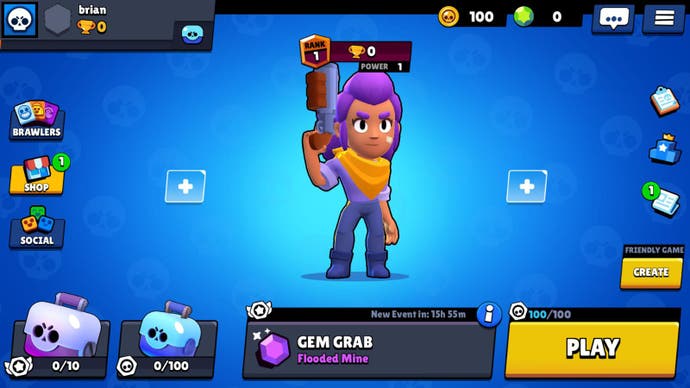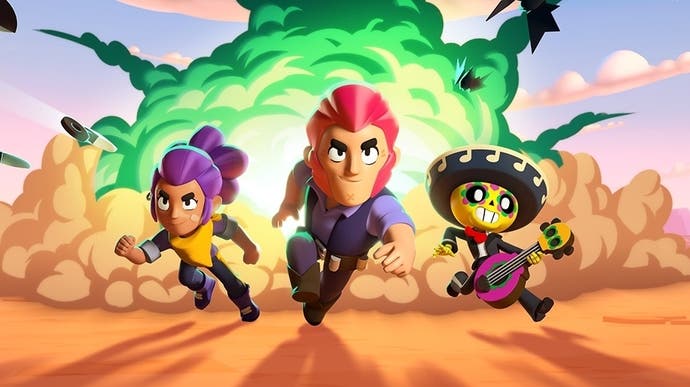The challenges and advantages of casual approachability in Brawl Stars esports
A visit to the World Finals in South Korea.
Mobile games are often considered broadly "casual," but scratch the surface of any of them and you'll find people who aren't playing casually at all. Your aunt's got 50,000 hours in Candy Crush. Other Eurogamer writers are in long-standing beefs with Animal Crossing: Pocket Camp octopi. I've probably spent more time in one fan-made calculator to maximise gatcha pulls in K-pop management game BTS World than anything else this year.
Even so, it's a leap from there to esports; professional competition that takes place on both a small mobile screen and a global stage. So, in November I attended the Brawl Stars World Finals in Busan, South Korea, to talk to some of the developers at studio Supercell and the championship's winning team about taking the eight-month old game very seriously indeed.
Brawl Stars is a recent entry in Supercell's stable of fiercely playable smartphone games. As the name suggests it's about facing off against a bunch of goofy characters in little arenas. It plays a bit like a twin-stick, and while it can feel chaotic at first, there's a lot of stuff to learn if you want to excel.
"You cannot plan an esports game," says Brawl Stars' game lead Frank Keienburg. "[But] we had a hunch that it would work well." He recounts the story of a company-wide event, before the game's release, where they hosted an internal competition on an early build.
"We sat in this huge room with a big screen. One of our community managers and one of our game designers commentated...we had like 150 people in the company playing competitively. ...At some point in the competition it got so heated, I saw that the wait staff who had never seen Brawl Stars [had] stopped waiting and they just stared at the screen."
"We were very sure that this would be big for esports," says community lead Ryan Lighton, citing the same moment. But, he explains, they waited for players to take the initiative first, watching community content creators establish their own leagues. After supporting these grassroots initiatives, they knew the demand was there for a first-party competition.

"If people who have never seen the game can follow it, that's something pretty magical," says Keienburg of the tournament that hooked the hotel staff. But retaining that accessibility, in both play and viewing, is an ongoing challenge. "Our whole philosophy is stripping away the clutter to make our games very...approachable," says Keienburg. "It starts with simple things other people might not think about at all. [For example] our file sizes are very small. Then afterwards, keeping the UI simple, clean, responsive."
But once players are in, there's a tricky line to walk in an attempt to engage a whole spectrum of people. "We have a lot of players...who maybe play a couple of times a week to some of the guys on stage [at the World Finals] were saying they play six hours a day. So that's a really wide variety!" Lighton laughs.
"If you don't have characters who have a higher skill ceiling, then it will result in the more engaged players and the hardcore players being bored very quickly. But if you have too many hard characters, then the casual players who just log in once a week will be upset, because they will feel like, I can't win with this. So it's a very fine balance," Keienburg explains.
Part of the solution, he says, is regular updates. "We don't have a fixed cadence, but we are looking at about once a month." And it's not just balance that the team are considering, but whether things just need a bit of a shake up. "In some cases it's more interesting to change the meta than to have a perfect meta. Because it can be very stale after a while...you could argue that everything's nice and balanced but if it's boring to play and boring to watch, that's not a good thing."
With characters spanning a wide variety of skill ceilings, esports players naturally gravitate towards the trickier ones that present higher risk for greater reward. This in turn escalates the difficulty for viewers, who might be much less knowledgeable players. "Making our content accessible to the more casual, less skilled players, but also making it relevant and interesting for our super skilled base [is a challenge]," says Supercell's esports lead Chris Cho.
As in any competition, much of the solution comes down to the commentators. "[Brawl Stars World Finals casters] Lex, Woody, and KairosTime, they are so good at taking really high level intense gameplay and making it understandable for everybody. All three of them have a background in either YouTube or Twitch, which I think tremendously helps," says Lighton.

The winners of the World Finals, Nova Esports EU, might not be the people who these accessible broadcasts are intended for - but they still see proof that they're working. (The team consists of three members, Tom "Cerulean" Green, Thomas "Tom" McLaren, and Spencer "Spen" Hendley, but they opt to speak to me as a unit.) "We all had family and friends at home who had never played or even seen the game before who were screaming at the screen," they tell me. "They loved watching it and not just because we were in it."
But with Brawl Stars only having been out for eight months, all of the developers I speak to are refreshingly honest that this isn't something they've completely solved yet. ("We are often misquoted that we are celebrating failure," Keienburg says. "We're not celebrating failure, we're celebrating learning.")
One issue is the brief nature of the games - great if you're waiting for a bus, not so brilliant if you're on the world stage. "When you have shorter content, it's harder to...manage the cadence or the rhythm of your esports competition," says Cho. "[Other] esports games, they tend to last longer, from 20 minutes to 40 minutes. We have the unique challenge of starting a game, to the end, it may take three minutes. For Brawl sometimes it's 50 seconds."
Keeping viewers' attention in between those short rounds isn't easy, especially because they are often watching from their phones. "It's so easy for them, the moment their interest level drops, to turn on their Instagram, or turn on our games." (Sitting in the back of the arena for the Brawl Stars World Finals, I can see the phone screen of the person sitting in front of me. They're playing Brawl Stars.)
There's also the simple fact that Brawl Stars has only been out for eight months (though it was in beta for 18 months before that). Its competitive scene isn't yet established, and these live and die on the stories they are able to tell about their players to get fans invested. But, points out Cho, with little history to go on, it can be tricky to sell the excitement. "There's kind of an aspect of an awareness issue with the players and with any newly launched tournament," he says.
Again, this is something broadcast commentators can help with. "Woody, for all of these events does his research...he has a little book with background on all of the teams and how they got to the World Finals, and he can sprinkle in this information along the way...which is really helpful for people who are just tuning in," Lighton explains.
Nova's story is a pretty good one. All three players participated in the beta, but Spen has the longest competitive history. He had some success and was subsequently signed to team Nova, but his career was disrupted when the competitions became regional - and he was the only UK-based player on an otherwise American roster. He was teamless "for quite some time," until meeting Cerulean and Tom in a Discord server and eventually joining with them as Nova Esports EU - and of course going on to win the finals.
But, story of overcoming obstacles though it might be, it does highlight the instability that still surrounds Brawl Stars (and all esports, to greater and lesser extents). And while there are more competitions coming up, the Nova players had to go "back to everyday life," in the meantime. "Spen went back to work, Cerulean and Tom went back to school," they say.
And so, even the best players in the world aren't sure how to describe Brawl Stars. "It still sort of feels like a casual thing even after such an amazing trip like that."


